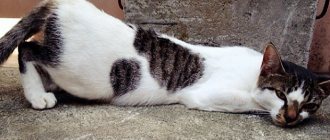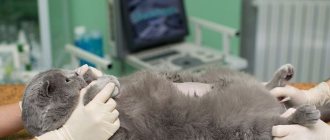13160Administration
1
Cats mark their possessions in much the same way as male cats. Many owners have encountered the problem of a cat marking during heat. The main difference is that to leave a mark, females can begin to shit, scattering excrement. Cats also mark their territory more frequently. This is due to the fact that they are very sensitive to odors and they must be sure to prevent the presence of foreign odors from other animals.
How to calm a cat during heat
What to do with a cat during heat? Provide load. Play active games with her that would distract her from searching for a male. In addition, if the cat gets tired, it will sleep at night and not scream wildly. For the same reason, do not allow the animal to sleep a lot during the day.
Be affectionate with your pet, pay attention to it - pick it up more often, talk to it, pet it. These actions will not muffle the sexual instinct, but the baby will be less nervous.
What to give a cat when she's in heat
To calm the predator, you can give the cat a sedative during heat (Cat Bayun, Stop-Stress, Anti-Stress, Fitex). Check with your doctor about the best medications to give to correct the behavior of cats. Give preference to plant-based potash. They act gently, without addiction.
Why does a cat mark during heat: 7 reasons
Females also leave marks during periods of sexual rest, but they do this on the sly, realizing that they are at the lowest hierarchical level in the pride.
But sexual instinct makes a cat behave like a dominant female and carry out self-affirming actions in the following situations:
- The presence of strangers encroaching on its territory. The cat considers such animals, in addition to other pets and family members.
- Detection of competitors behind the door by smell and sounds or on the street while viewing the surrounding area from the windowsill.
- Exacerbation of a chronic disease: if a cat has cystitis or urolithiasis, bowel movements are painful, and during sexual heat the urge becomes more frequent. Sensitivity increases, and the cat associates painful urination with the tray or litter. She believes that in another place, bowel movement will not be accompanied by pain. The search for the treasured place can continue endlessly.
- Searching for a partner: the female does not realize that she is in an apartment and not on the street. Instinct forces her to do what is supposed to be done in the wild.
- Stress is a condition caused by the unfavorable effect of environmental factors - travel, moving, meeting an aggressive dog.
- Guests arrived , people or new pets - potential competitors who could push the female out of the hierarchical step occupied in the pride.
- Another cat or animal living in the apartment has leaked. This is a tough test for the inexperienced animal lover.
Be sure to read:
Mating males and females: features, age, how to determine readiness, first mating, recommendations
When do cats go into heat and how often?
After estrus begins for the first time, the months must be counted based on the appearance of the first symptoms. How many times do cats go into heat? On average, it happens every 3 months. Thus, the answer to the question of how many times a cat goes into heat per year is 4 estrus periods. But every rule has an exception. For some pets it happens once a month, for others - once every six months.
How often cats go into heat depends on various factors. If the pet has given birth, estrus will begin in 4-6 months. If the offspring died or the kittens were taken prematurely, the estrus will occur earlier.
Over the years, the time between heats may increase, or less often, it may decrease. The season also influences the appearance of estrus. Street animals become more excitable in early spring and autumn, while in winter they are silent. As for domestic animals, they do not depend on the time of year; the season does not affect the desire to mate.
How long does a cat's heat last?
A cat's first heat occurs around six months after birth. Sometimes maturation is delayed up to eight to ten months. The onset of late estrus within a year and a half, as well as early estrus up to six months, indicates a hormonal disorder and is a deviation from the norm.
Some kittens can be in heat as early as four months and even become pregnant. In this case, the cats are culled and sterilized - this feature of the body can be inherited. A long delay is a reason to consult a doctor. Perhaps the cat is developing incorrectly and has significant deviations in physiology.
The average duration of estrus is a week and depends on the age of the cat. The older the cat gets, the longer the “spring”. With old age, the duration and frequency are significantly reduced, and estrus passes without ovulation.
Untied cats shed on average once every three months, chaste pets ask for a cat more often, about once a month. If a cat mates constantly, she will come into heat every six months. There are cases when a new mother begins to leak within a month and a half after lambing. In some breeds, for example, Scottish Straight, Scottish Fold, British Shorthair, the period between estrus stretches for six to eight months, and the “female” cycle can be five days.
The first heat, duration, and frequency depend on the cat’s temperament, diet, daily routine, and the presence of cats in the neighborhood. As a rule, active pets begin to leak before their phlegmatic “sisters”. Being near a cat can spontaneously trigger the onset of the cycle.
Stages
Estrus is a complex physiological process consisting of four stages.
- Proestrus. Preparatory stage, lasting up to four days. A cat may show excessive tenderness towards its owner, but maintain its usual lifestyle. The vulva - the external genital organ - swells. Discharge begins, but the pet is not yet ready to accept a cat.
- Estrus. Actually, in heat. Lasts seven to ten days. At this stage, even an inexperienced owner notices how his beloved cat is in heat. The pet begins to meow protractedly, crawl on the floor, and caress towards people and objects. Ovulation occurs around the third to fifth day of estrus. These days the cat can be mated.
- Metestrus. Over the next three to ten days, the cat's libido decreases, and the pet calms down. After mating, at this stage the cat shows aggression towards cats, this is a sure sign of pregnancy. If fertilization does not occur, the cat may develop a false pregnancy during the third stage of estrus. This condition is dangerous for the physical and mental health of the pet and is associated with hormonal imbalance and genetic predisposition. The cat should be monitored. If she starts carrying things (socks, mittens), making a “nest,” or “feeding” soft toys, then it is better to immediately contact a veterinarian.
- Anestrus. The final stage of the cycle. The pet completely calms down and returns to its normal lifestyle.
The time of year does not affect the onset of estrus. If your pet was born in June, puberty should be expected in December. However, in winter there is a “lull”; the cycle passes relatively unnoticed and calmly. The hormonal surge begins in February-March and can last until the onset of cold weather, depending on the length of daylight hours.
How to punish a cat
Hitting and poking with the muzzle are ineffective, although common methods. Often they lead to the exact opposite result, because an angry animal begins to “mark” more and more inappropriate places with excrement, for example, the carpet, sink, bathtub.
If you need to punish a cat, you will have to do the following:
- Apply punishment only at the moment when the cat is caught at the “scene of the crime,” and do not delay it for a while.
- Punish until you achieve the desired result.
- Consistency, don't make exceptions.
- It is strictly forbidden to hit the animal with your hands, maximum with a rolled up newspaper.
What else can you do to calm a cat so that it doesn’t scream?
There is another interesting method, which we will talk about in more detail. This is an artificial induction of ovulation, which can be done using:
- mating of a female with a castrated cat
, which is active towards the girl in heat, but does not have the ability to fertilize the egg. But the problem is that we still need to find such a cat. Yes, so that he does not have sexually transmitted infections that can be transmitted through mating;
- specific massage
. The procedure consists of holding and pressing the female to the floor with one hand, and with the other you need to stroke the animal on the back and lightly press with your finger in the tail area. The cat itself will tell you, with frequent, dancing movements and screaming, where its excited erogenous point is. After successful massage strokes, Kisulya will roll and somersault on the floor in a fit of euphoria. He will be happy to catch his tail with his paws and lick it in a frenzy. This means the massage achieved its goal: it caused ovulation;
- imitation of sexual intercourse
. Hold the dog by the withers in the same way as for a massage. At the moment when the female begins to move her tail to the side with a cry, carefully insert a handy object lubricated with Vaseline oil into the vagina. The insertion depth should be no more than two centimeters. The simulator can be a cotton swab wrapped in a piece of a condom or the tip of a thermometer. The process will need to be repeated several times. The egg is not fertilized as a result of artificially induced ovulation, but progesterone in the blood increases. This hormone is needed to maintain a possible pregnancy. False pregnancy does not occur in the cat, but the animal calms down and does not disturb the household members with sexual desire for a long time.
Features of behavior
Females start asking for a cat at around 6-9 months of age, this will also depend on the breed. If during the period of heat the cat asks for a male, and you plan to breed kittens, it is better to postpone mating until at least one and a half years. At too early an age, up to a year, cats do not always manage to produce healthy offspring.
Those owners who have not had cats before should know some of the peculiarities of the onset of estrus. During this period, not only physical but also psychological changes occur in the animal. Characteristic features include the following:
- The animal's behavior changes suspiciously. The pet can be overly affectionate or overly aggressive.
- “Cat songs” last a very long time and do not stop even at night. All this is accompanied by a loud, inviting meow.
- Urination becomes more frequent.
- The gait becomes unnatural: paws are bent and the tail is raised up.
- Appetite decreases.
- The pet begins to lick the genitals more often (due to discharge).
- The animal may begin to mark its territory; sometimes the cat shits during heat, including on the bed.
We invite you to read: Dirofilariasis in cats, routes of infection, symptoms and treatment
It is worth noting that during heat, one or more of these signs may appear. This period rarely occurs without symptoms.
Signs of estrus in cats
People around him and the cat itself suffer from unsatisfied natural needs of the body.
An inexperienced owner may not immediately understand that his pet has gone into heat.
A number of signs confirm this condition:
- Swollen genitals, clear fluid oozing.
- Reducing the time between urinations.
- Constant meowing, the cat instinctively calls for a male.
- Loss of appetite.
- The desire to run out of the house. Owners must keep windows and doors closed.
- Change in emotional state: increased affection (the animal caresses people, rubs against furniture) or uncontrollable aggressiveness (scratches, bites).
- Typical movements: arching the back, stomping with the hind legs, pressing the tail to the side.
After making sure that the cat is going through a period of sexual activity, you should take measures to alleviate the pet’s condition.
How to stop a cat from marking in the apartment
The following techniques will help you get rid of a bad habit and teach your pet to be neat:
- It is necessary to catch the animal in the act and punish it immediately. If you do this after a few minutes, it will not understand why it is being scolded.
- If your pet marks in the corners, make these places less attractive. To do this, you can spray them with persistent perfume or lemon juice.
- Give your cat medications during heat, but be sure to talk to your veterinarian first. Many drugs are strong and have side effects.
- Periodically distract your pet with games, various activities and toys.
You can try spraying or spreading catnip around your apartment.
But the most important thing is to show patience and attention to the animal.
Use of specialized tools
Many owners use hormonal drugs to solve the problem, but experts have different views on this issue. Taking such compounds can lead to negative consequences. You can give them to your pet no more than twice a year. With more frequent use, the risk of developing malignant neoplasms and other inflammations of the genital organs increases.
If you decide to wean your cat off a bad habit using hormonal medications, be sure to consult your veterinarian. He will select the most suitable remedy, taking into account all the characteristics of the animal.
Will sterilization help if the cat is marking its territory?
One way to solve this unpleasant problem is to sterilize the animal. The appropriate age for this is the period before the onset of the first heat. This is approximately eight to twelve months. In this case, the cat must be physiologically ready, and only a specialist can confirm this after a thorough examination. During sterilization, the female's testicles and uterus are removed.
The pet needs to be prepared the day before surgery. The main recommendations are as follows:
- do not feed the animal twelve hours before the procedure;
- prepare specialized wound treatment products;
- Perform general cleaning in the house to prevent infection.
One way to solve an unpleasant problem is to sterilize the animal.
Sterilization is performed by abdominal surgery through a small incision in the abdomen. The uterus and ovaries are removed using a scalpel, after which the wound is covered with stitches and a bandage. All manipulations last about thirty minutes. After them, it is advisable to take the animal home so that it calmly recovers from the anesthesia. When this happens, you can give your pet water. It is very important to follow all doctor’s orders and give your cat medications to avoid complications.
A sterilized cat should not mark. If this phenomenon is still observed, the cause may be a poorly performed operation, severe stress, or the presence of the odor of males. In rare cases, animals continue to mark territory out of habit.
What to do if your cat shits anywhere: useful tips
Screaming, physical punishment, poking your face into a puddle or pile are ineffective methods that are best abandoned immediately. If your pet does not have any obvious health problems, it is recommended that you start training it immediately. First, the prankster should be brought to a puddle or heap and scolded in a stern, but not loud voice. Cats are smart and intellectually developed animals, so they will immediately understand by their intonation that something is wrong.
Next, it is recommended to analyze whether there are any problems with the cat litter, litter, and hygiene. If the cat clearly does not like the tray, it is better to buy a new one. In addition, it is recommended to observe how the litter behaves after the animal goes to the toilet. If the granules emit an unpleasant odor after contact with urine or feces, it is better to choose another one with a neutral odor.
When a pet walks past the litter box during heat, it needs to be spayed or neutered. It is important to establish a close emotional connection with your pet, because if the owner constantly offends the animal and severely punishes it, you should not expect exemplary behavior and respect in return. An offended cat will definitely find an opportunity to take revenge by making a pile or a puddle in unexpected places. Therefore, if you accidentally upset your pet, it is better to make peace with him by calmly talking, playing and treating him to his favorite treat.
Often, a cat will leave traces of urine or feces on the floor because it has health problems. The owner is obliged to pay attention to the general well-being of the animal. And if your pet has a fever, pain, discomfort while visiting the toilet, and foreign inclusions are noticeable in the urine and feces - mucus, blood, pus, you should not hesitate to visit the veterinarian. After a diagnostic examination, the doctor will make an accurate diagnosis and prescribe treatment. As soon as the original source is eliminated, the animal will begin to relieve itself in the tray as before.
If an adult street cat, accustomed to peeing and pooping anywhere, refuses to go to the litter box, in addition to well-known training methods, special tools for litter box training will help combat this. The drugs are sold in pet stores mainly in the form of sprays.
If you don’t want to poison your pet with chemicals, you can use folk remedies that should be used to treat the places that the animal likes to mark the most. Strong smells will frighten him and help stop him from shitting near the litter box. The following home remedies have worked well:
- Ammonia;
- Perfumes with a sharp, persistent odor;
- Onion garlic;
- Natural oil of rosemary, mint, lavender, lemon, orange;
- Vinegar;
- Floor paint.
Use of folk remedies
In addition to store-bought remedies, folk remedies are used to accustom a kitten to the litter box and discourage it from its usual place.
A popular way to keep a cat away from a corner is to use citrus products. The shell of oranges and lemons, due to essential oils and other components, repels animals with its aroma. It is important to replace such a “repellent” in time so that it does not lose its smell and does not become a toy for the animal.
An animal should not be punished for using a corner as a toilet after it has done so. You need to scold your pet if you catch him at the crime scene. Then the cat will understand that this cannot be done.
Tray training is required for any animal taken into the home. This responsibility falls entirely on the owner.
Kirill Sysoev
Calloused hands never get bored!
Not one owner of a cute furry pet is immune from the appearance of an unpleasant “surprise”. The reasons for this behavior of a kitten or an adult cat may be different. The owner of the cute creature can only find the right solution and, using simple methods, wean the cat from shitting anywhere before it becomes a bad habit.
The cat shits past the tray: possible reasons
If an adult cat begins to shit in the wrong place, it is first important to find out what kind of situation influenced this behavior, because an animal cannot just dislike its old litter box and start defecating anywhere. The science of zoopsychology deals with the study of the character and habits of felines. Scientists argue that the reasons for this behavior are physiological and pathological.
The animal does not like the smell coming from the litter box
Some people don't keep their cat litter clean. This may be due to a lack of free time, or simply the cat owner saves litter in this way, preferring to change it as rarely as possible. Naturally, the tray itself is not washed often.
It is known that cats are clean animals and they will not want to start relieving themselves in a dirty toilet. However, the need does not disappear, so the animal solves it in its own way - it goes to pee or poop in a corner, under the sofa or on the carpet.
The cat doesn't like the litter box itself
If your pet starts shitting outside the litter tray, you should make sure that the reason is not in the toilet itself. Sometimes even the most expensive and popular tray may simply not be to the animal's liking. For example, a product that is too bright in color, has high or low sides, and creates an unpleasant plastic smell.
Many cats are afraid of a closed litter box, especially if it is cramped and small. It is these factors that contribute to the fact that a previously neat and obedient pet begins to crap everywhere.
Unpleasant odor from the filler
Sometimes it's easy to get your cat to relieve itself in the litter box if you change the litter to a different one. It has been noticed that the cheap ones have a sharp, unpleasant odor, which, when combined with the aromas of urine and feces, begins to emit a fragrance so that the pet is afraid to even approach the litter box, let alone go to it. Breeders advise choosing litters that have a neutral aroma that the cat will not run away from.
Inconvenient location of the cat litter
For example, if the tray is installed in a room where it is noisy and crowded all the time, some pets will simply be embarrassed to relieve themselves in front of strangers. The animal will not be able to concentrate to pee or poop, so the pet will go in search of a quieter place.
It is not recommended to place a cat litter box in a place where the pet rests or eats. It is unlikely that a cat will want to shit where he drinks, eats or sleeps.
Association with something negative
Some owners, having taken a kitten home, simply do not know how to properly teach it to use the litter tray. And if an inexperienced baby accidentally makes a puddle on the floor, the owners will immediately begin to scold, and some even beat the baby. Then you shouldn’t be surprised that from an early age the animal is afraid of the tray and experiences stress when it appears.
Resentment towards the owner
If the owner accidentally offends his four-legged friend, he, in revenge, wanting to annoy him, will ignore the tray and make a puddle in an unexpected place. In this way, the animal can express emotions and dissatisfaction.
Lack of attention
If the owner spends little time with his four-legged friend, rarely plays, and does not take him out for a walk, the cat, wanting to attract attention, will begin to play dirty tricks, spoiling and scattering things, taking shit anywhere.
The appearance of something new in the house
If the owner has purchased a new thing, for example, a sofa, wardrobe, bed, the cat, sensing an unfamiliar smell, will want to leave its mark on it.
Stress
If a new pet, a newborn child or a guest appears in the house, this will alert the cat, frighten it, and make it worry. The animal understands perfectly well that this new resident will take away some of the owner’s attention and love. Due to stress, a cat's behavior can be unpredictable. Some pets stop eating and drinking, while others show their state of mind by leaving puddles or even piles on the floor.
Sexual hunting
In cats of popular breeds such as Sphynx, Persian, British, Siamese, Scottish Fold, estrus begins at the age of 7–9 months. If the owner does not plan to have offspring, and at the same time is in no hurry to castrate and sterilize the pet, you should not be surprised that the animal behaves inappropriately at such moments.
Due to sexual overstimulation, cats begin to mark their territory, trying to attract a potential partner using scent. Cats may leak urine during heat, causing puddles to appear on the floor in unexpected places.
Early age
A small kitten does not immediately remember where its toilet is located. Owners of babies picked up from the street should also be patient. Such kittens are accustomed to relieve themselves in any convenient place - under a bush or in the grass. It will take a little more time to train the foundlings to go to the tray and not past it, but it will be worth it.
Dangerous diseases
One of the worst reasons why your four-legged friend goes past the litter box is illness. For example, if a cat develops pathologies of the urinary system, then during the act of urination or defecation the animal feels severe pain. In such situations, the tray is associated with a place where pain and discomfort torment him. Often cats shit anywhere due to diseases of the digestive system, poisoning, and helminthic infestations. Additional symptoms that may prompt you to contact a veterinarian include:
- Weakness, lethargy;
- Refusal to eat;
- Vomit;
- Weight loss;
- Increase in temperature;
- Problems with bowel movements and urination.
There is a popular belief that a cat that shits on the owner’s bed or personal belongings predicts illness and sometimes even premature death. However, it is still worth interpreting superstition objectively, because an animal can relieve itself for understandable reasons - severe pathologies, old age, and even banal boredom.
A change of scenery
Do cats mark territory? As we found out, yes. Moreover, they do this for reasons that the owner does not always pay attention to. Let's say that the house is being renovated. Everything changes: the usual wallpaper, furniture. For people this is joy, but for cats it is wild stress. So she begins to protest, expressing her protest with marks all over the house.
Or the owners had to move to a new place of residence along with their pet. It is possible that the cat will begin to mark corners in a new house or apartment. What is unimportant for the owners, the cat looks at it from a completely different angle.
Sterilization - is it worth it or not?
Sterilization should be carried out at an early age, so the cat will more easily tolerate anesthesia. However, the owner must understand that there will be no turning back. The cat will lose the ability to bear children forever.
On the one hand, it will not be possible to protect your pet from cats all the time, and an empty heat greatly traumatizes the animal. For a cat to remain healthy, it must be allowed to reproduce.
Veterinarians suggest sterilizing the animal if there is no need for childbearing (the cat is not purebred and it will be difficult to place the kittens). Firstly, it eliminates the cat’s stress during the hunt, and secondly, there is peace and quiet in the house.
Among other things, unsterilized cats often develop health problems: purulent inflammation of the uterus, tumors of the mammary glands, cysts on the ovaries and hormonal disorders.
Pros:
- There will never be kittens. Although there were cases when the owners had to regret their decision.
- One hundred percent effective. Medicines may malfunction, be taken at the wrong time, or for some other reason they may not bring the desired effect.
- Safe surgical process.
Minuses:
- After surgery, your cat will need time to recover. She may be lethargic and not feel well.
- Don't forget about the price of the issue. It may be more convenient and financially advantageous for someone to purchase special medications.
- If you suddenly want to get offspring from a cat, you can no longer correct what has been done.
- The cat's body will undergo irreversible changes. This may result in excess weight gain, and the animal may become inactive and apathetic.
If the owner has decided to sterilize a cat, then it is worth paying increased attention to the animal’s nutrition in order to minimize risks and improve its health. You should choose food exclusively for sterilized cats.
What to do if a cat marks in the apartment?
How to get rid of the problem once and for all? There is only one truly effective solution - castration, carried out before the onset of puberty. Yes, most owners are frightened by this option - how can you send an animal to such a barbaric and humiliating operation for it? However, the facts speak exclusively in favor of timely removal of the testes - and here are the advantages worth considering:
The first and most important thing is that the cat will stop marking its territory, ruining clothes and shoes, and leaving odorous marks on furniture. The second plus is that in the spring you will not be disturbed by the heartbreaking cries of a male trying to reason with his rival or call a female
The second plus is that in the spring you will not be disturbed by the heartbreaking cries of a male trying to reason with his rival or call a female.
The third advantage of this elective operation is the reduction in the level of aggression. A previously angry and irritable cat will become affectionate and obedient.
Veterinarians also point out that castrated animals live much longer than those whose owners, out of the kindness of their hearts, preserved their gonads. The pet's character changes for the better and remains playful and cheerful until old age.
Removing the testes is also a great way to protect your purr. Adult uncastrated cats have a high risk of developing tumors and prostate adenoma, and various infections. Agree, preventing their occurrence is much easier than treating your pet over and over again.
So, if you don’t intend to find a spouse for your Barsik or Boris, but the desire to live in a clean and comfortable house without odorous marks does not allow you to put up with the disgusting smell emanating from the carpet, linoleum, slippers and other things that catch the eye of the animal, there is only one way out – castration. This way you will save the cat from suffering when searching for a female and stop cleaning at the slightest provocation.
By the way, a similar operation exists for cats – this is sterilization. It helps get rid of most of the problems that owners of these graceful pets face during heat. You can read more about the need to remove the ovaries of a female and the rules for preparing for surgery here.
The emergence of aggressive behavior and its conditions of occurrence
The cat may begin to behave threateningly, hiss, and constantly make strange, unfounded sounds that sound like a scream. For a female, changing the room in which she is located is stressful and, in this case, the cat may not allow the cat to be mated to her. Therefore, when a cat is moved to another house with a cat, the female demonstrates aggressive behavior. Here you can only use special drops or spray to make the cat calm.
When mating, it is important to leave the cat and the cat in the same room for several days, where there are no people. This is due to the short time for animals to get used to each other, and even an inexperienced cat, the cat can be intimidated and nothing will work out for them
Reasons why mating may not work
- A young and insecure cat. If the cat is not in its territory or is too young (1 year), then its behavior will be cautious and unsure. This can scare away the cat and nothing will come of it.
- The cat did not find anything attractive in the “gentleman” and does not allow him to approach her. In this case, she takes a sideways position and begins to hiss; moreover, the process of hostility may be accompanied by attacking the partner.
- Disease. Before mating, you need to take your cat to the veterinarian, since various diseases usually affect this process. Even a slight malaise can have a negative impact, and then the cat won’t let the cat in anywhere. Possible pain during the mating process in a cat can be caused by inflammation of the glands, which is why the cat will not let the cat near and may rush at him. In addition, there may be pain during the normal process of estrus.
- The cat is not in heat or has already ended, which means the cat has not reached sexual maturity.
- The cat must be well-fed, so leave food for both animals and trays (each with his own) in the room. And also don't forget about water. Hunger, like illness, has a negative effect on cat instincts. If your furry pet has experienced a lack of appetite or apathy for several days before making the decision to mate, then you need to cancel all plans to merge a cat and a male cat.
- Another very important factor. It is necessary to take into account the age of the animals and their breed. Mating often does not work out if they differ at the genetic level, and then the cat may simply not allow the newly arrived cat to approach her.
How can you help your pet during a difficult period?
Due to the fact that during estrus a cat marks especially strongly, this period is difficult for owners. It is worth noting that aggressive psychological influence on the animal: intimidation, screaming will not help in this situation . You should use all your patience, show affection and care. What can be done in this case?
You can try the following:
- Do not raise your voice, talk to your pet calmly and affectionately, calm him down.
- You can pat the animal on the head and gently scratch its belly (you cannot touch the tail).
- To release excess energy, when the cat begins to mark, give her “tasks” from time to time. For example, catch or bring a toy.
- You need to feed in small portions, but the amount of water should be sufficient, especially in hot, stuffy weather.
- It is also permissible to bathe your pet in warm water, but there should be no drafts in the room.
Calming herbal preparations also help well. They are not addictive, so how often the animal likes to “walk” does not matter. For example, stress-relieving drugs: “Cat Bayun”, “Fitex”. You can also try catnip in bags or in spray form (spray or place in your pet’s favorite places).
Stages of estrus in cats
Estrus in a cat, or scientifically known as estrus, is a physiological process necessary for further procreation. Sexual desire in cats is divided into four categories: preliminary, estrus, metestrus, and end of the cycle.
The preliminary period - proestrus is characterized by an increase in the size of the follicles located in the ovaries. They contain a mature egg. During proestrus, there is an increased production of the female hormone estrogen.
The cat at this stage is not ready to mate and become fertilized, but the owner may notice changes in the behavior of the pet. The animal becomes more demanding, wants more attention, appetite decreases, and it can damage furniture. There is pronounced swelling in the area of the external genitalia, and mucous discharge appears. The duration of this stage is from 2 to 4 days. After it comes the estrus itself.
Estrus, or true estrus, is the stage most suitable for fertilization of an egg by a sperm. This period is characterized by increased cat activity. She screams invitingly and waits for the male, behaves strangely indoors, crouching to the floor, raising her butt, can swing it from side to side, and bends her tail.
Depending on the character of the animal, signs of true estrus may vary. Thus, more temperamental females become aggressive and excessively noisy, but calmer females will not be so eager to leave the house, but will still annoy the owner with their behavior. The duration of true estrus in cats varies from person to person, but on average ranges from a week to 14 days.
The third period of estrus in a cat is metestrus, which is a decline in sexual desire, the behavior of the pet changes dramatically. Instead of affection and screams, aggression towards males occurs. An unfertilized female becomes calmer, and in the case of fertilization, the animal prepares for the upcoming pregnancy.
In some cases, metestrus without fertilization turns into a pathological state such as false pregnancy. This phenomenon is extremely similar to normal pregnancy - the female builds a nest for the “future” offspring, the mammary glands swell, and colostrum is released.
This condition is dangerous for the animal, as it can provoke a serious hormonal imbalance in the body and requires corrective treatment under the supervision of a veterinarian.
The fourth period is anestrus, characterized by the end of the sexual heat cycle. The cat becomes calm and balanced. Under normal conditions, estrus in a cat is a physiological process and does not require any outside intervention from the owner in the form of injections and tablets. It is necessary to show maximum attention to the animal, in no case scolding, and also without locking it in the room. The use of physical force is prohibited, as it can provoke serious psychological trauma in the animal.
Tag prevention
Owners are often stunned by the strange behavior of their charge. Panic from the series “the cat is marking its territory, what should I do?” - a popular request, since not all parents know about the physiological features of their pets. Hormonal surges force animals of both sexes to mark. Especially if people are not concerned about timely sterilization. Therefore, the best prevention of bad behavior is sufficient attention to equipment, which will ensure the most correct conditions of detention. And to eliminate a bad habit, you will need sensitivity, tolerance and attention to your cat. After all, we are the ones responsible for those we have tamed.
When to sterilize?
For cat owners, the relevant question is why sterilization of the animal is necessary. Females are able to bear offspring without even reaching one year of age. During the period of estrus or puberty, the cat marks corners, behaves aggressively, may begin to scratch, meow loudly, especially at night. The owner begins to get annoyed by this and the problem arises: “when can a pet be sterilized?”
Puberty in cats occurs at about 6-8 months of age. Of course, this is the middle age; in fact, this happens individually for each female and may occur a little later, closer to a year. To figure this out, you need to visit a veterinarian.
Most veterinary experts believe that the appropriate age for spaying is before the first heat, approximately 8-12 months.
For young individuals, this is the safest time for surgery. To carry out sterilization, the animal must be physiologically ready. Only a specialist can provide such information after examining your pet.
A young cat that has not yet had its first heat has its ovaries removed during sterilization; in an older animal, the uterus and ovaries are removed. Doctors usually insist on removing the uterus, because after some time inflammatory processes may begin in it. You don’t have to wait until the first heat to remove the uterus, but a prerequisite for the operation is that the female is physiologically formed.
© shutterstock
Preparing a cat for surgery
You need to start preparing your pet one day before sterilization. Basic preparation recommendations include:
- Do not feed the animal 12 hours before surgery. You should discuss the exact time of the procedure with your veterinarian in advance.
- Prepare special means for treating the animal’s wound.
- Give your home a thorough cleaning to prevent your cat's wound from becoming infected.
Sterilization of an animal is carried out by standard abdominal surgery. Through a small incision on the stomach. The uterus and ovaries are then removed using a scalpel. Next, stitches are placed on the wound and a bandage is made. The operation lasts about 30 minutes. After 10 days, the bandage can be removed when examined by a veterinarian.
After surgery, it is better to take the animal home so that the pet can calmly recover from anesthesia. When the cat recovers from anesthesia, you can give it water to drink, but do not feed it yet. You should follow all the doctor’s recommendations and give all medications to the animal on time to avoid complications. Remember, for sterilization, choose a good veterinary clinic and check with your doctor about the time of the operation.
If the cat asks for a cat and marks, but you do not plan to breed offspring, sterilization will be the best option.
The female will stop persistently demanding the cat and marking her territory. The apartment will no longer have a sharp, unpleasant smell. The pet will stop being aggressive. You will also save not only your own nerves, but also your personal property from possible odorous marks.
To carry out such a procedure, as already noted, it is important to select an experienced specialist. After surgery, you will need special care for some time. If you follow all the recommendations, there will be no unpleasant consequences for your pet.
A sterilized cat should not mark. If a pet marks after sterilization, this may be due to a poorly performed operation (when the ovaries were not completely removed). This may also be due to the following reasons: severe stress (moving, unfamiliar people in the house), or the presence of the smell of males (in your house or nearby). In rare cases, females, like males, may continue to mark according to an old habit.
It is very important to specify this moment and understand whether the cat is marking territory or simply urinating in the wrong place. The animal’s posture will help determine what is happening.
During tagging, liquid hits a vertical surface, and the pet's tail jumps at this moment. If what happens is different from the above example, your pet may have problems with the urinary system or latrine.











